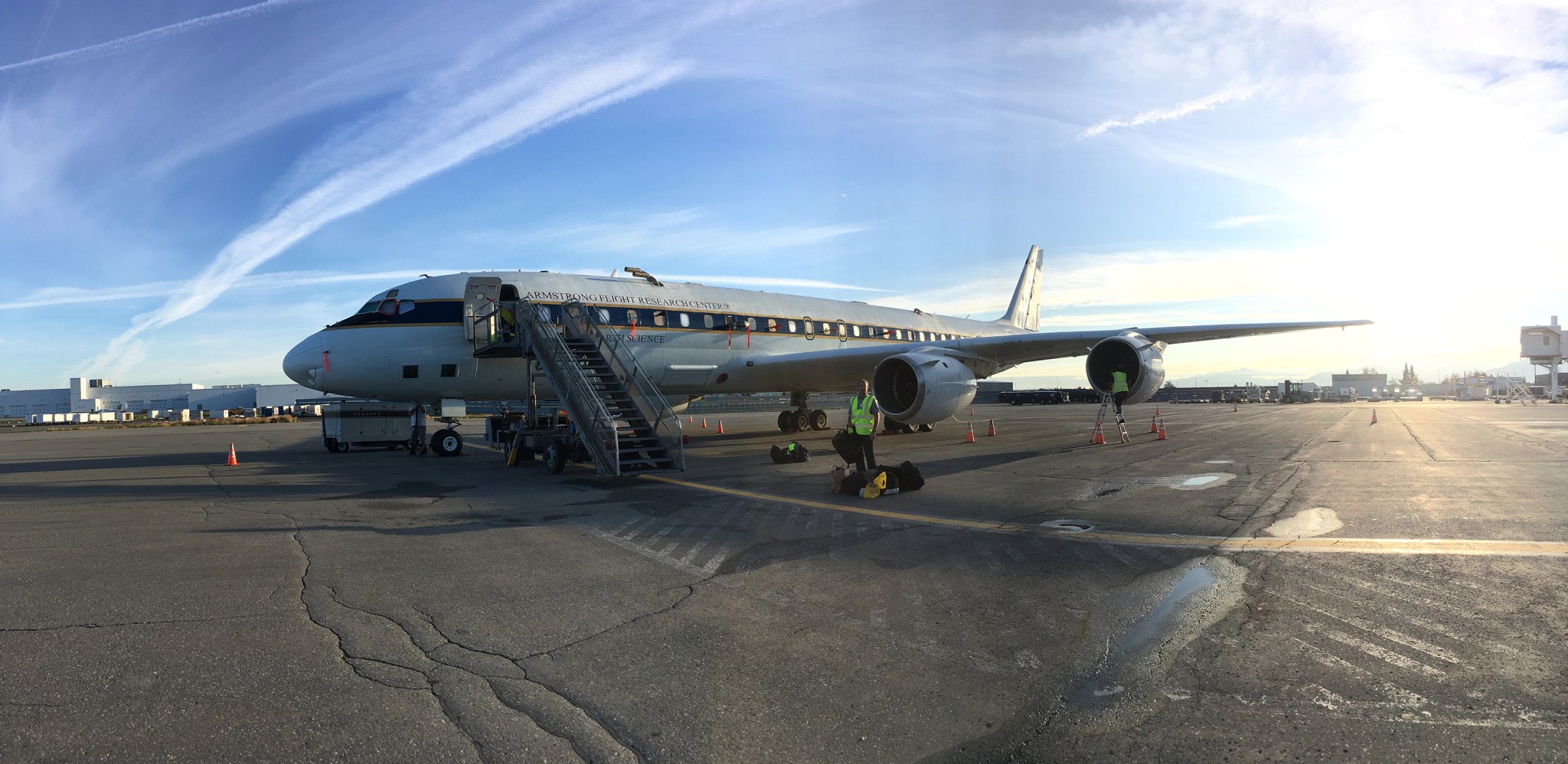Earth is a planet that breathes with the seasons. In winter months atmospheric gases and air pollution accumulate, waiting dormant until spring and summer bring sunshine and plant-life, sparking transformations that change the make-up of gases in the atmosphere. A NASA airborne mission will take a world-wide survey of these seasonal transformations by flying from the heart of winter in the Northern Hemisphere, down into the sunny summer in the Southern Hemisphere and back again.
This will be the second atmospheric survey made by the Atmospheric Tomography, or ATom mission, which first flew in July and August, 2016. The science team will be measuring more than 200 gases as well as airborne particles aboard NASA’s DC-8 flying laboratory. In particular, they are interested in greenhouse gas pollutants such as methane and tropospheric ozone, and poorly understood particulates like black carbon. How these pollutants interact and move around the planet will help scientists better understand air pollution and climate change now and in the future.
“We’re going to the northern polar regions at the very best time,” said Steven Wofsy, an atmospheric scientist at Harvard University in Cambridge, Massachusetts, and ATom’s project scientist.
This winter, they expect to observe the accumulation of pollutants from Europe, the United States, Canada, northern China, and Russia, which get trapped in the cold dome of the wintertime circulation until spring.
“We’ll be watching this chemistry using instrumentation that nobody has had before, and we will really be beginning to understand what happens as this stuff builds up,” Wofsy said. The winter accumulation of gases sets the stage for the chemical processes that occur in the atmosphere when sunlight returns to the Arctic.
Sunlight is energy, and in the same way that it supports life on Earth through plants’ photosynthesis, it also drives the chemical system in the atmosphere. Incoming ultraviolet radiation provides high energy photons that can tear apart gas molecules, transforming them into new highly-reactive fragments. One of ATom’s science goals is to understand these photochemical processes which help remove pollutants and greenhouse gases from the atmosphere.
These photochemical processes will be in full swing as the mission flies from Alaska down the Pacific Ocean to New Zealand and the Southern Hemisphere summer.
“We’re heading into the southern hemisphere in prime time,” said Michael Prather, an atmospheric scientist at University of California Irvine and ATom’s deputy project scientist. “This is when sunlight’s down there. It’s the biggest photochemical activity. It’s the biggest biological activity of the southern oceans.”
Because the Southern Hemisphere holds fewer land masses and less of the world’s population, the southern atmosphere is generally cleaner than that of the Northern Hemisphere. According to Prather, this means it will potentially be easier to observe gases and particles, particularly from marine plants, that react with gases already in the atmosphere. Ocean-related reactions are currently poorly understood and are one of the main reasons ATom is making its survey.
“To get the detail we need, in an attempt to better understand the atmosphere, we need to survey as much of it as possible so we will be flying vertical profiles through the atmosphere from 500 feet above the ocean surface up to 35,000 feet, where commercial airliners fly,” said project manager David Jordan of NASA’s Ames Research Center in Mountain View, California.
For the around-the-world-journey, NASA’s DC-8 aircraft will carry more than 20 scientific instruments that measure both major and minor gases as well as particles. The plane is about the size of a medium-sized commercial airliner and bristles with intake valves to sample the air. It will make a nearly continuous series of gentle descents and ascents in order to capture the most chemically active part of the atmosphere, from the relatively warm humid air above the ocean surface as well as the colder, dry air at its peak altitude of 35,000 feet, and everything in between.
After an initial flight from NASA’s Armstrong Flight Research Center in Palmdale, California, to the equator and back, the DC-8 will make nine stops over the course of 28 days, departing from California for the North Pole, then on to the tropics, the Southern Ocean around Antarctica, and across to the southern tip of South America before flying north over the Atlantic ocean toward Greenland, then across the Arctic ocean back to Alaska. The final leg will return the science team to California.
ATom’s winter mission will be the second of four deployments that will take place through 2018. It is funded by NASA’s Earth Venture program and managed by the Earth Science Project Office at Ames. A team of over 100 people—scientists, engineers, flight crew and staff—across government agencies and universities will be supporting the mission both in the air and from the ground.
For more information about the ATom mission, visit:
https://www.nasa.gov/content/2016-earth-expeditions-atom
NASA uses the vantage point of space to increase our understanding of our home planet, improve lives, and safeguard our future. NASA develops new ways to observe and study Earth’s interconnected natural systems with long-term data records. The agency freely shares this unique knowledge and works with institutions around the world to gain new insights into how our planet is changing.





























